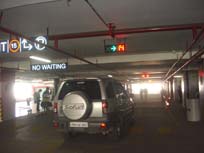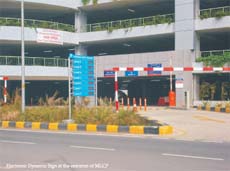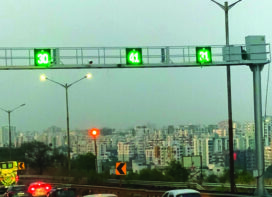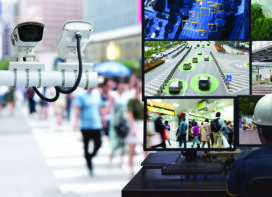 Terminal 3 at Delhi, the world’s eighth largest airport terminal, is known as much for its Multi Level Car Parking (MLCP) services as for its strong infrastructure, splendid design and impressive facilities. Along with the European technology of Automated Parking Management, the project also offers an ambitious Guidance System for the first time in India – SADS (Space Availability Display System) that directs the motorist towards vacant bays and slots on each floor, thus doing away with the tiresome process of circling the parking area in search of a vacant slot. Behind the technology and installation of the Parking and Guidance System is FAAC India, the Indian arm of Italy’s FAAC (Fabbrica Automatismi Apertura Cancelli which stands for Gate Opening Automated Systems) which was established in 1965 in Bologna.
Terminal 3 at Delhi, the world’s eighth largest airport terminal, is known as much for its Multi Level Car Parking (MLCP) services as for its strong infrastructure, splendid design and impressive facilities. Along with the European technology of Automated Parking Management, the project also offers an ambitious Guidance System for the first time in India – SADS (Space Availability Display System) that directs the motorist towards vacant bays and slots on each floor, thus doing away with the tiresome process of circling the parking area in search of a vacant slot. Behind the technology and installation of the Parking and Guidance System is FAAC India, the Indian arm of Italy’s FAAC (Fabbrica Automatismi Apertura Cancelli which stands for Gate Opening Automated Systems) which was established in 1965 in Bologna.
The terminal was conceived on an area of 502,000 m² in Delhi and with an annual capacity of handling 34 million passengers. On such a massive project, tackling the issue of parking services carefully and thoroughly became a crucial point of focus. DIAL (i.e. Delhi International Airport Pvt Ltd – the joint venture consortium of which GMR is the lead member, the others being Fraport AG and Eraman Malaysia) decided to include the guidance system as well along with parking management in order to ease and simplify the parking process. After a strict and meticulous screening process, FAAC India was awarded the contract of developing and installing the customised parking facilities and guidance system on the merits of its Paragon Parking System. The company had the advantage of a location in close proximity (its head office is in Noida) along with having every facility in-house, i.e. a complete system with no need to outsource. “The selection of FAAC was done through a tender process. Proposals were invited from major parking equipment vendors. The evaluation criteria included technical and financial evaluation. FAAC provided the best proposal overall,” says a DIAL spokesperson.
“GMR had a very strong evaluation team for the project and its major concern was the after-sales services and a proper  set-up of the company in question as the terminal’s large traffic would demand chaos-free parking management,” says Anuj Tyagi, National Sales Manager, FAAC India. “FAAC had everything in-house. Outsourcing leads to a certain disadvantage if a misunderstanding or confusion arises between the main company and the concessionaire. As there was to be a combination of parking and guidance systems, in case of such an emergency, GMR might have got into trouble once the system was in running mode. The fact that we had expertise in the guidance system along with the parking system went in our favour,” he adds. Says the DIAL spokesperson, “The guidance system is a state-of-the-art system and definitely one of the best in India. It is the first deployment of a guidance system on such a large scale.”
set-up of the company in question as the terminal’s large traffic would demand chaos-free parking management,” says Anuj Tyagi, National Sales Manager, FAAC India. “FAAC had everything in-house. Outsourcing leads to a certain disadvantage if a misunderstanding or confusion arises between the main company and the concessionaire. As there was to be a combination of parking and guidance systems, in case of such an emergency, GMR might have got into trouble once the system was in running mode. The fact that we had expertise in the guidance system along with the parking system went in our favour,” he adds. Says the DIAL spokesperson, “The guidance system is a state-of-the-art system and definitely one of the best in India. It is the first deployment of a guidance system on such a large scale.”
After technical evaluation, the DIAL team visited FAAC’s head office in Bologna, Italy to check the company’s set up and its ability to handle such a massive project. The fact that it has manufacturing set-up in over three countries and possesses  a good reputation in the European market went in its favour too. The team also saw FAAC’s installation of some parking sites in Rome. Ashfak Alam, Project Manager, FAAC India who was in-charge of the entire installation process at Terminal 3, says, “It is a lesser known fact that initially we were offered only the Guidance System but once the GMR team saw our plants in Italy and our earlier work, the entire contract came to us.”
a good reputation in the European market went in its favour too. The team also saw FAAC’s installation of some parking sites in Rome. Ashfak Alam, Project Manager, FAAC India who was in-charge of the entire installation process at Terminal 3, says, “It is a lesser known fact that initially we were offered only the Guidance System but once the GMR team saw our plants in Italy and our earlier work, the entire contract came to us.”
The agreement was that an expert from the parent company would come to India and stay here during the entire period of the customised development and installation of the project. So, Marco Deepak came to India for the entire period. Says Alam, “It was supposed to be completed in 11 months but as the multi level car park wasn’t ready in time, FAAC got only four months (March 25, 2010 to July 27, 2010) i.e., only 124 days for the entire installation process.” The site, which has 40 kms of conduit and 300,000m of cabling, is in operation 24/7 and FAAC provides services and preventive maintenance to Delhi Parking Management Services.
MLCP and Guidance System
 MLCP, with its five levels plus terrace parking – which is not in use yet – witnesses the entry of about 10,000 to 12,000 vehicles per day. It has six entry points and five exit points. Once a vehicle approaches the parking area, right at the entrance on the ground level, an Electronic Dynamic Sign guides the motorist about the vacancies on each floor. At the entrance, the motorist just needs to push the button of the ticket dispenser which automatically dispenses the ticket with the entry time. The ground and second floor parking areas are for premium parking as they lead directly to the terminal and metro station – the motorist can just park, pay and walk through the gangway to the terminal. These two floors also offer multiple pay stations and parking on these floors is costlier.
MLCP, with its five levels plus terrace parking – which is not in use yet – witnesses the entry of about 10,000 to 12,000 vehicles per day. It has six entry points and five exit points. Once a vehicle approaches the parking area, right at the entrance on the ground level, an Electronic Dynamic Sign guides the motorist about the vacancies on each floor. At the entrance, the motorist just needs to push the button of the ticket dispenser which automatically dispenses the ticket with the entry time. The ground and second floor parking areas are for premium parking as they lead directly to the terminal and metro station – the motorist can just park, pay and walk through the gangway to the terminal. These two floors also offer multiple pay stations and parking on these floors is costlier.
Says the DIAL spokesperson, “Terminal 3 is the first airport in India to provide a multilevel car park with a capacity of over 4300 cars. The connectivity to the Terminal from the parking area is via an air conditioned skywalk. A number of entry/exit gates and entry/exit ramps have been created to ensure that passengers take less than five minutes to park their car and less than five minutes to exit from the car park. This parking targets one of the most stringent SLAs for a car park in India and also has a centralised payment system so that passengers need not queue at the exit. Multiple payment booths at each floor also ensure that the passengers take minimum time to make the payment. The parking area has CCTV cameras, Public Address and Fire fighting system to ensure safety and security of the passengers.” A motorist can find parking space within five minutes with the help of the electronic dynamic signage and the guidance system.
 The guidance system gives information on the vacant bays in each row. Says Tyagi, “The Parking Management System mainly involves hardware like cone barriers, ticket dispensers and automatic paying stations at the entry and exit points. Parking Guidance System, on the other hand, is a new system which tells the motorist right at the entry point about the availability of each vacant space so that on entering the parking lot, he doesn’t have to travel all over looking for parking space. Further, in every row, the system guides him where he can park. Every parking bay has an ultrasonic sensor fixed on the roof that picks up its occupancy status. Based On it, it shows a green LED light in front of the bay if space is available, and a red light, if it is occupied. So once you are in, you can simply follow these lights. It is very convenient. Entirely a new system for the Indian market, it required immense technical expertise and integration.”
The guidance system gives information on the vacant bays in each row. Says Tyagi, “The Parking Management System mainly involves hardware like cone barriers, ticket dispensers and automatic paying stations at the entry and exit points. Parking Guidance System, on the other hand, is a new system which tells the motorist right at the entry point about the availability of each vacant space so that on entering the parking lot, he doesn’t have to travel all over looking for parking space. Further, in every row, the system guides him where he can park. Every parking bay has an ultrasonic sensor fixed on the roof that picks up its occupancy status. Based On it, it shows a green LED light in front of the bay if space is available, and a red light, if it is occupied. So once you are in, you can simply follow these lights. It is very convenient. Entirely a new system for the Indian market, it required immense technical expertise and integration.”
 TrafficInfraTech Magazine Linking People Places & Progress
TrafficInfraTech Magazine Linking People Places & Progress


